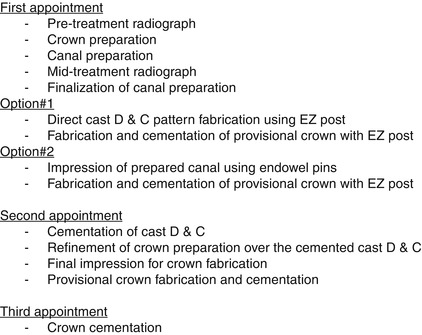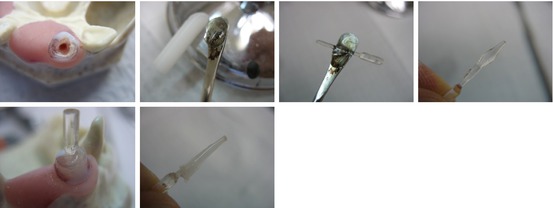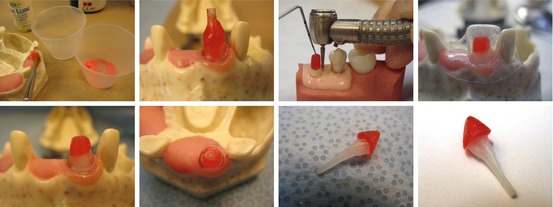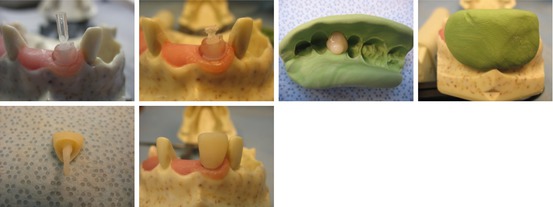Where Can I Buy Plastic Dowel With A Polymer Nail In America
Fig. 11.1
Brusque mail tin induce stress concentration to the side of root dentin upon bending moment therefore tin induce root fracture easily. The longer the post, the more evenly the forces are distributed over the length of the root therefore less chance for the root fracture is present
11.3.3 Practitioner'southward Clinical Expertise in Root Canal Preparation
(a)
If canal preparation is off centered, the cutting edge of the drill might induce a ledge in the centric wall of root dentin. A root dentin wall with the ledge can exist thinner, and stress can be concentrated due to the shape of ledge, which may increase the risk for root fracture failure when a cast D&C is used.
(b)
Curt canal training might pb to a short bandage post, which in plow may increase post debonding and the chance of root fracture.
(c)
A wide root canal preparation may leave a thin root dentin wall, which may increment the risk for root fracture.
(d)
A root canal preparation that is too long or an inadequate gutta-percha removal technique may compromise the iv–5 mm apical seal. Equally seen in Chap. ane , an insufficient apical seal may issue in endodontic failure.
11.three.iv Cementation/Bonding Technique for Bandage D&C and Crown
Inadequate bonding of bandage D&C to the root dentin or using a mechanically weak luting cement can increment mail service debonding equally well equally the possibility of root fracture. Inadequate bonding of full-coverage crown to the cast D&C/tooth margin or using weak cement can increase crown dislodgement chances (Heintze 2010; Kainose et al. 2014).
xi.4 Clinical Sequences to Fabricate Cast D&C and Subsequent Total-Coverage Restoration
Once a cast D&C is selected equally a choice of treatment over the prefabricated fiber post and core build-up from careful clinical and radiographic examinations, the endodontically treated tooth is prepared for a final total-coverage restoration. Clinical sequence of cast D&C and crown treatment is presented in Fig. eleven.2.

Fig. xi.two
Clinical sequence of bandage D&C and crown treatment
Unless an endodontist has already prepared the canal space, the crown grooming is performed first earlier root culvert preparation for cast D&C is initiated (Fig. xi.3). After an ideal crown grooming, the platonic post length is determined using a radiograph. The ideal post length is the longest possible length with 4–five mm apical gutta-percha seal remained, while mail service width should not be thicker than ane third of the root diameter. Unless an endodontist made a perfect canal preparation, further gutta-percha is removed using either a heated endo plugger (#5–7, #9–eleven) or the Arrangement B (SybronEndo). If none of these are available, proper size Gates-Glidden bur and Peeso reamer is used to remove gutta-percha and ready the canal space (Fig. 11.4). Before finalizing the canal training, mid-treatment radiograph should be taken to make sure that the canal training is centered and an adequate apical seal is maintained. Using an fairly sized Peeso reamer, culvert preparation is carefully finalized. Ideally, no gutta-percha or ledges or severe undercuts should be present on the axial wall of the prepared canal space to achieve maximum bonding of cast D&C to root dentin wall and to reduce chances of root fracture upon severe loading.

Fig. 11.3
Prior to canal training, an ideal canal grooming is performed, if an endodontist has not prepared canal space already

Fig. 11.4
The ideal post length is determined from the radiograph. Gutta-percha removal and canal preparation are performed using either a heated endo plugger (#5–7, #9–eleven)/System B or Gates-Glidden or Peeso reamer, if endodontist has not prepared the canal space already. Mid-handling radiograph is strongly recommended prior to finalizing the culvert training
11.4.1 Direct Blueprint Technique Using EZ Postal service and Self-Curing Resin
Making a pattern directly from patient'due south mouth is indicated for an endodontically treated single root unmarried tooth cast D&C restoration. The ideal shape of a direct pattern tin exist finalized in the patient'southward mouth, and a direct design will be sent to commercial laboratory for casting. This aforementioned technique tin can be used for fabrication of provisional restorations for both straight pattern and indirect impression cast D&C fabrication techniques. The post component of the cast D&C direct pattern is fabricated using EZ mail arrangement (white compound and plastic endowel; Merritt EZ Cast Post Inc.) (Leong et al. 2009). The white thermoplastic compound is heated until it becomes clear color melted state. The plasticized chemical compound is picked up with the plastic endowel and placed into the prepared culvert of a tooth in the patient'due south rima oris. Once the material cools downward to a white solid compound, the plastic endowel with the white compound is removed from the root canal (Fig. xi.v). If the removed white compound postal service has a void or is brusk from the orifice of the canal, additional melted compound is added, and post is placed back into the canal space to make a perfect post shape. Once the post portion of the cast D&C directly pattern is completed, the cadre portion of the direct pattern is made using self-curing acrylic resin (Pattern Resin LS, GC America Inc.).

Fig. 11.five
Straight cast D&C pattern fabrication using the EZ post organization (white thermoplastic compound and plastic endowel). The white compound cloth will plough into clear color once it is heated. Melted compound is picked upward with plastic endowel and placed into the prepared culvert. Once the colour changes to white upon hardening, the plastic endowel with white compound is removed from the root canal
Once the endowel postal service is fully seated into the canal in patient'due south oral fissure, the polymer and monomer of the pattern resin is practical effectually the plastic endowel using a sable brush. One must exist conscientious non to drop monomer or polymer of resin into patient'southward soft tissue. In one case enough self-curing resin is applied around the endowel post and once resin is set, the core portion of the direct blueprint is prepared using a diamond bur in situ. In case the direct D&C pattern is not stable during training, hold the blueprint down in position using a periodontal probe. The core portion of direct design should be continuous from the remaining cervical portion of tooth construction, and no extra wink should be left. Remove completed one-piece directly D&C pattern to make sure that the cadre portion is well fastened to the postal service department. If a vacuum shell preparation guide is bachelor, try it over the core portion of the pattern to brand sure that an ideal core shape is achieved. In one case the core portion fabrication is completed to an platonic anatomy, a directly pattern of D&C is evaluated for its passive seating into the canal space. To reduce the chance of root fracture induced by cast D&C in the long term, the concluding cast D&C should seat passively without any friction to the axial wall of root dentin. Whatsoever white compound or blood-red cocky-curing acrylic resin of straight D&C pattern engaging undercuts should be reduced using hot wax spatula and/or diamond bur until an accented passive fit of direct pattern to the canal space is achieved (Fig. eleven.vi).

Fig. 11.six
The core portion of the cast D&C pattern is added around the plastic endowel using self-curing acrylic resin (Pattern resin) and a sable brush in patient'southward mouth. Later on setting, the core portion is prepared for an ideal abutment, while the direct cast D&C design is held down in position with a periodontal probe. A vacuum shell preparation guide can be used to confirm the ideal preparation of the core portion. Direct cast D&C pattern should accept seamless transition to the remaining tooth structure and seat to the culvert passively after eliminating any undercut date from the EZ post pattern
Set aside a direct pattern of D&C in a attachment purse to avert misplacing it. One extra EZ post is created using the same technique to fabricate a jumpsuit conditional crown with EZ post. One time the post portion is made, the handle of plastic endowel is turned into the nail head using a hot #7 wax spatula. Brand certain that the white chemical compound mail service with plastic nail head is seated fully in patient'due south mouth and the putty matrix for the provisional crown is not interfering with the boom head. The provisional restoration material is applied into the putty matrix, and this matrix is seated onto the tooth. Subsequently setting, the jumpsuit provisional crown with EZ post is removed from the canal space. At this point, we should audit the provisional crown to brand sure that the junction between the provisional crown and the white compound mail section is potent and seamless. In this specific example, an EZ postal service undercut engagement is desirable to proceeds additional retention for the provisional crown. This crown is cemented using a temporary cement. The cement is applied merely under the crown margin, not effectually the EZ post, to ease the removal of cement from the canal infinite at a subsequent engagement (Fig. eleven.7). Apoplexy should exist carefully adjusted and patient is dismissed. The direct D&C pattern is then sent to commercial laboratory for casting.

Fig. 11.seven
An boosted EZ post blueprint is fabricated for fabrication of a conditional crown using same technique. Instead of adding the GC pattern resin to create the core portion of the straight blueprint, a nail head is created using hot #7 wax spatula against plastic endowel. Provisional restoration textile is applied into the putty matrix, and this matrix is seated onto the tooth. Later on setting, the 1-piece provisional crown-EZ post is removed from the canal infinite. In this instance, an undercut engagement of the EZ postal service is left for additional retentivity of provisional crown. The provisional crown-EZ post is cemented using a temporary cement
11.4.2 Indirect Impression Technique
This impression technique of the prepared canal space is indicated for multiple teeth cast D&Cs or multiple pieces of bandage D&C in a multi-rooted single molar. Making direct D&C patterns for multiple teeth in the patient's mouth is not an efficient use of time. Also, if patient is significant or is allergic to self-curing acrylic resin, the indirect impression technique is indicated even for a single bandage D&C fabrication.
Merely gold members can continue reading. Log In or Register to continue
Source: https://pocketdentistry.com/cast-dowel-and-core/
Posted by: leflorewevere.blogspot.com

0 Response to "Where Can I Buy Plastic Dowel With A Polymer Nail In America"
Post a Comment